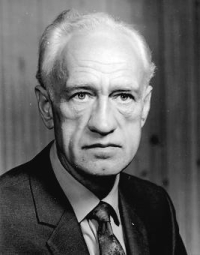
John Wesley Neill is often spoken of as the patriarch of landscape architecture in British Columbia, yet he was born to a clergyman in Salford, Ontario, and spent the first decades of his life in western Ontario. In 1938, he graduated from Guelph’s Ontario Agricultural College, specializing in ornamental horticulture. For two years, he worked in publications, editing and managing magazines such as “Canadian Florist” and “Canadian Horticulture and Home”. Then war intervened; he enlisted and by 1943, Major Neill was a tank commander. He earned a Military Cross for gallantry, and at war’s end, helped produce a film about his tank: “the only Allied tank which landed on the beaches of Normandy on D-day, and was still in fighting trim at the end of the war.”
In 1949, Neill moved to the Horticulture Department at UBC, where he was campus supervisor and began his doctorate studies with Oregon State University (Ph.D., 1955). For the next 14 years, he told Linda LeGeyt in Changing the Face of Canada, “I had the campus, the botanical garden and the nursery to run… those were wonderful years.” And for students in his ornamental plant identification courses, his campus horticultural walkabouts were legendary.
Neill set up a well-stocked nursery. His knowledge of rhododendrons was extensive: he provided choice specimens to the Rhododendron Species Foundation in Federal Way, Washington, and he planted rhododendrons in groves on campus. (When the nursery was decommissioned years later, many large rhododendrons were moved to UBC’s Botanical Garden.)
A landmark achievement for UBC, achieved through the constant support and facilitation of John Neill, was the construction of the Nitobe Memorial Garden, the first post-war garden of reconciliation in Canada (1959-60), designed and directed on site by Japanese Professor Kannosuke Mori. (Ron Williams tells the story in Landscape Architecture in Canada.)
As UBC prepared to launch its new program in landscape architecture (established in 1970), Neill was integral to shaping the program, and in 1980, became its director. During those remarkable decades, he and Philip Tattersfield convinced the BC Legislature to pass the provincial Landscape Architect’s Act (1968), and helped found the BCSLA (1966). Neill became its first President, serving for five years.
Neill also worked assiduously with advocates from UBC and BCSLA to make landscaping of roadways mandatory in construction projects in B.C., organizing multiple conferences and conducting research to build an inter-disciplinary approach.
During early retirement (1988), he edited Trees of Greater Victoria: A Heritage, linking the histories and locations of some 300 historic trees into a compendium and tree guide. To honour his service to the profession, BCSLA established the John Wesley Neill Medal, awarded to an outstanding graduate in Landscape Architecture each year.
SOURCES
Tribute to John Wesley Neill, B.S.A., M.C., Ph.D. (Hort.), LMBCSLA, FCSLA. By Clive Justice. “Sitelines”, BCSLA, October 1999.
John Wesley Neill, Ph.D., in Changing the Face of Canada, Volume 2. By Linda LeGeyt (1998).
PHOTOS
Portrait photo: John Neil fonds – 1949-1975. Compiled by Jean Beck (1985). University of British Columbia Archives.
Nitobe Gardens, designed by Kannosuke Mori of Chiba University, Japan, and facilitated by John Neill. For the garden story, see Landscape Architecture in Canada, by Ron Williams.
Photo courtesy Sachi Williams.
